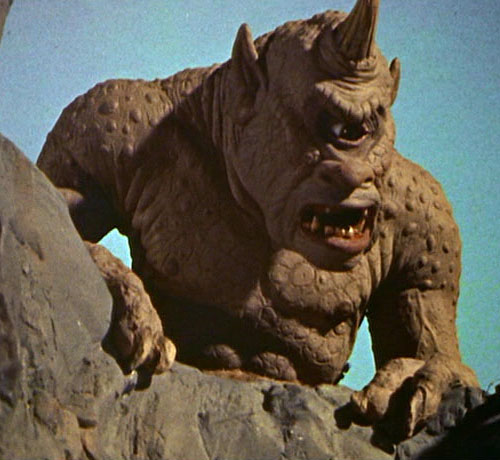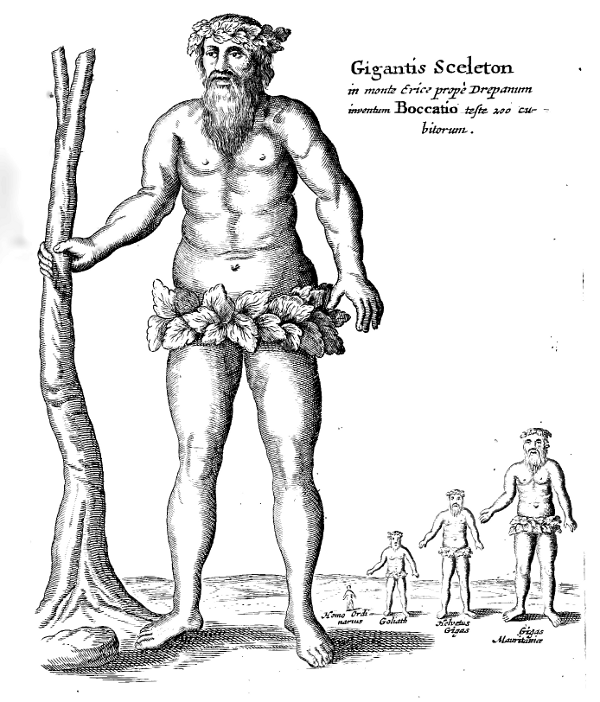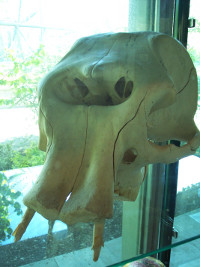
Few things are better for the soul than a breath of legitimate history, so let’s take a deep inhalation of smog and investigate the skull of the Cyclops. Word came my way that in 14th century Sicily the bones of just such a monster had been unearthed, and the locals immediately hailed it to be the skeleton of Polyphemus, the Cyclops who taunted Odysseus in The Odyssey and Aeneas in The Aeneid. For readers who didn’t squander the Springtime of their youths studying the Classics (and you should be ashamed for not doing so), Odysseus told Polyphemus that his name was No-one. Thus, when Odysseus blinded the Cyclops and the other Cyclopses1 came to help, Polyphemus had to shout out “No-one is slaying me!” Stupid man.
The first report of our Cyclops in the real world comes from Boccaccio in his Genealogia deorum gentilium libri (Genealogy of the Pagan Gods, c. 1360). For readers of naughty books, this is the same Boccaccio who wrote a whole bunch of medieval comedy/porn in The Decameron. About Polyphemus, however, Boccaccio writes:
There is still much to say if we want to solve the mystery of these stories. But first it is not completely fictitious that there have been giants — men far exceeding others in form or stature. This remains true, as the recent happenings in the town of Trapani, Sicily have demonstrated.
At the foot of the mountain that stands out over Trapani not far from the town, a few rustics were digging the foundations for a country home when they discovered the entrance to a cavern. When the eager diggers lit small torches and entered to see what was inside, they found a cave of the greatest height and breadth. As they walked through the cave, opposite the entrance they saw a seated man of massive size, from whom the terrified men suddenly took flight and left the cave. They came down into town back the way they came, telling everyone what they had seen. The curious townsfolk went to see what evil this was, lighting torches and taking up arms just as if uniting against an enemy state.
More than three hundred people entered the cave. No less stunned than the first men, they saw what the others had reported. When they realized that the man was not alive they drew closer and saw him sitting on a seat. He had supported himself with his left hand on a staff of such height and thickness that it exceeded any mast of a massive ship. He was a man of both unseen and unheard of size, and in no way decayed or diminished. When one of them, reaching out his hand, touched the mast, it immediately collapsed into dust. Beneath it another staff remained, this one made of lead, rising up to the hand that held it. When they had examined it, they realized the lead had been poured into the staff to increase its weight. Later the weighers carried it and those who saw it thought it must weigh 15 of Trapani’s hundredweights, any one of which is equal to a hundred of the common kind.
At last the height of the man, having been touched, fell to the ground the same way, and nearly everything was turned to dust. When they handled it, three teeth of monstrous size were found still solid. Moreover they weighed three rotuli, i.e. one hundred of the common ounces. In testimony of the giant they had discovered and in the everlasting memory of posterity, the Trapanites tied the teeth to an iron thread and hung them in a church that had been built for the Annunciation of the Virgin and was called the same name.
Later they discovered the anterior part of the skull was still very firm and capable of holding very many measures of grain. They also found an upper bone of the leg, part of which had decomposed into rot as if from extreme old age. Those who could tell the whole height of a man by measuring the smallest fragment ascertained that he had been 200 cubits or more in size.
It was suspected by certain of the wisest people that this had been Eryx, a most powerful king of the region, son of Butes and Venus, killed by Hercules and preserved in the mountain. But certain people decided it was Entellus, who once killed a bull with his fist in the funeral games held by Aeneas for his father Anchises. Indeed others decided it was one of the Cyclopses — very possibly Polyphemus — about whom Homer wrote much, and later Virgil in The Aeneid.2
I don’t even need to spend my worthless time shooting down Boccaccio’s account. As it turns out the brilliant 17th-century polymath Athanasius Kircher has already given Boccaccio a face full of fives in Mundus Subterraneus. What I didn’t realize before looking this up was that Kircher was not only a great scholar, but also quite the humorist. Read his dissection and tell me it doesn’t have a whiff of the academic wit of Mark Twain or Richard Dawkins:
If, as Boccaccio reports about the Trapanian giant, a man of 200 cubits (which makes 400 geometric feet or 600 palms) had ever existed in the world, he would almost certainly have equaled the size of any tower. No colossus has ever been erected in the world which exceeded a few parasangs3. Here the diligent Reader may draw conclusions about the monster’s habitat, nourishment, and tyranny: for what dwelling could accommodate such vastness? What nourishment could be sufficient for such a maw? Certainly a whole flock of sheep and goats would barely have been enough for one day’s sustenance. An ox would be but a snack. For a drink he would surely have drained fountains and rivers. What clothes could fit such bulk? Certainly a ship’s sail could not have been anything but a small sash to him, and it would take 50 of them sewn together to make his clothes. Beech and fir trees could be nothing but a small, slender staff. But pray, what animal would have been safe from such savageness of such great speed that just one step would be 50 steps for an ordinary man? A blow of his fist or heel alone could flatten walls and houses, however firm and solid. He would have cut down whole armies no differently than a reaper cuts crops. I leave the innumerable other questions which occur to the diligent Reader to be unraveled by proportional reckoning, and so on with the rest of the giants, the vastness of whom we have demonstrated in the preceding table. But in order that the Reader examine the matter more closely, I have derived a diagram to be placed nearby, from which you may learn the proportion of ordinary men to the size of the aforementioned giants.4
To my delight Kircher makes good on his promise of a diagram and provides this instructional sketch of several men in their underpants.

I wish I could reproduce more of Kircher’s essay on the topic because it’s a complete delight, but then you might as well just grab a copy and enjoy it for yourself (immediately after learning Latin, of course). I’ll skip straight to Kircher’s great insight about the Cyclops:
The very distinguished Marquis [Carlo di Ventimiglia] added that several caves of this kind are found in Sicily, and while admiring similar caves ignorant peasants find likenesses of bones produced by the force of Nature, and persuade not just themselves that they are the enormous bones of giants, but also others; however he added that, in the Solonian field next to the sea, between Trapani and Palermo, actual bones of Elephants are still dug up by farmers, which in previous generations were introduced by the Africans to Sicily against the enemy in war5, and were killed and piled up in the same place. The bones were then laid bare in later times, and the ignorant also advertise these indiscriminately as the bones of giants. Indeed they discuss the symmetry of these bones compared with those of men, then further on they acknowledge that they will never agree to the truth because they each claim it so firmly. The Marquis added that this is the distinction between real bones and those produced by a natural mineral, because they always seem to retain the channels of the tibia and the tube-like courses once filled with marrow, but in fact these may disguise solid stone without any of the hollowness of tibias. Such are the stone bones, which even now are on display in our Museum, and because of which I have always believed them to be the work of Nature alone.6

Ah, now we’re really talking. First Kircher reports that these Cyclops bones are actually not animal bones, but something kind of “stone bone” produced by natural forces. He then muddies the waters with the discovery of the bones of elephants left over from Hannibal’s invasion of Rome. What he first describes are clearly fossils. It seems like a pity he neglected to connect the fossils with the elephants, because the current theory is that the Cyclops bones were not only elephant bones, but fossilized elephant bones from long before the Second Punic War. The Mediterranean used to have a unique species known as the Pygmy Elephant, whose bones you could easily mistake for a giant’s. There are no eye sockets on the front of the skull, but there is one big hole for the trunk (and presumably the Cyclops’ single eye).
I had hoped to get this post done before Halloween, but then I’ve clearly been a lazy arse about translating all the Latin. That said, just look at the skull of that Pygmy Elephant! If you came face-to-face with that in a dark cave, I think it would put the fear of God into you too. I think I want one perched above my chamber door like a bust of Pallas.
Notes
-
Technically the plural of “Cyclopses” is “Cyclopes”, but I’ve written about The Problem with Plurals previously. TL;DR: It’s okay to Anglicize plurals. ↩
-
Boccaccio IV.68. Translated from Latin by your helpful blogger. The paragraphs are mine because, like some kind of a hot-blooded anarchist, Boccaccio didn’t use paragraph breaks. ↩
-
According to Wikipedia, “a historical Iranian unit of itinerant distance comparable to the European league”. Who knew, right? ↩
-
Kircher VIII.2.VI ↩
-
The Second Punic War. ↩
-
Kircher VIII.2.VI ↩
-
By —MaxM 19:00, 26 May 2008 (UTC) (Own work (my own picture)) [GFDL or CC-BY-SA-3.0-2.5-2.0-1.0], via Wikimedia Commons. ↩
Bibliography
-
Bocatius, Ioannis. Περι Γενεαλογιας Deorum. Basilea apud Ioannis Hervagius, 1532. Print.
-
Kircherus, Athanasius. Mundus Subterraneus. Amsterdam: ex officina Janssonio-Waesbergiana, 1678. Print.